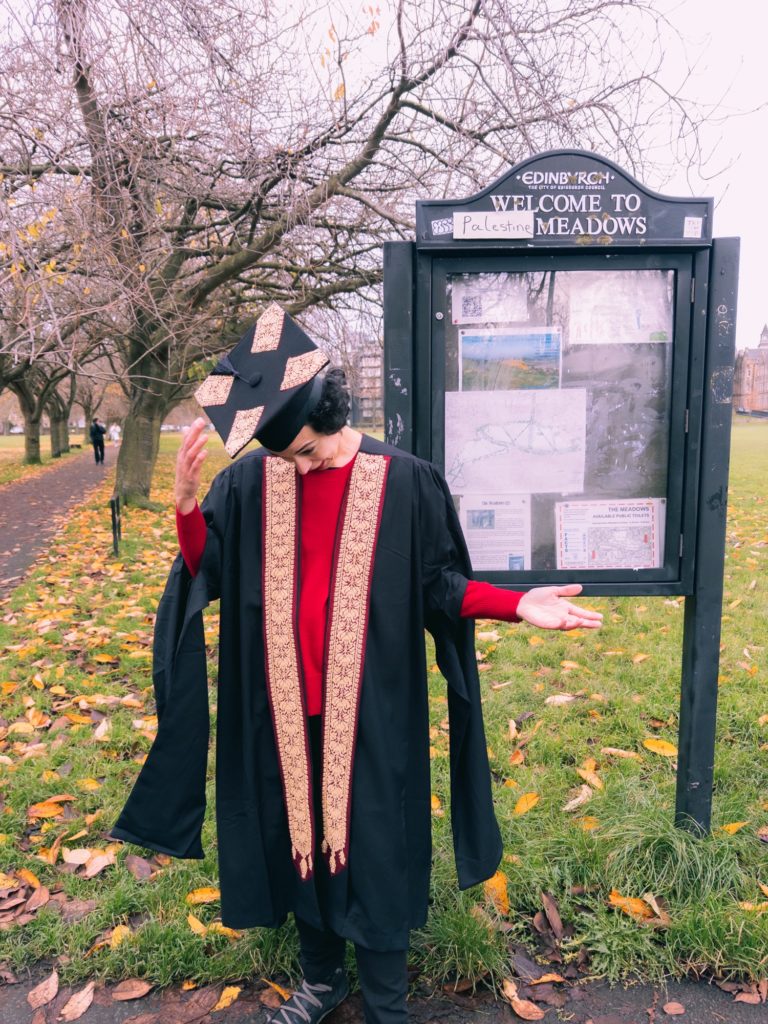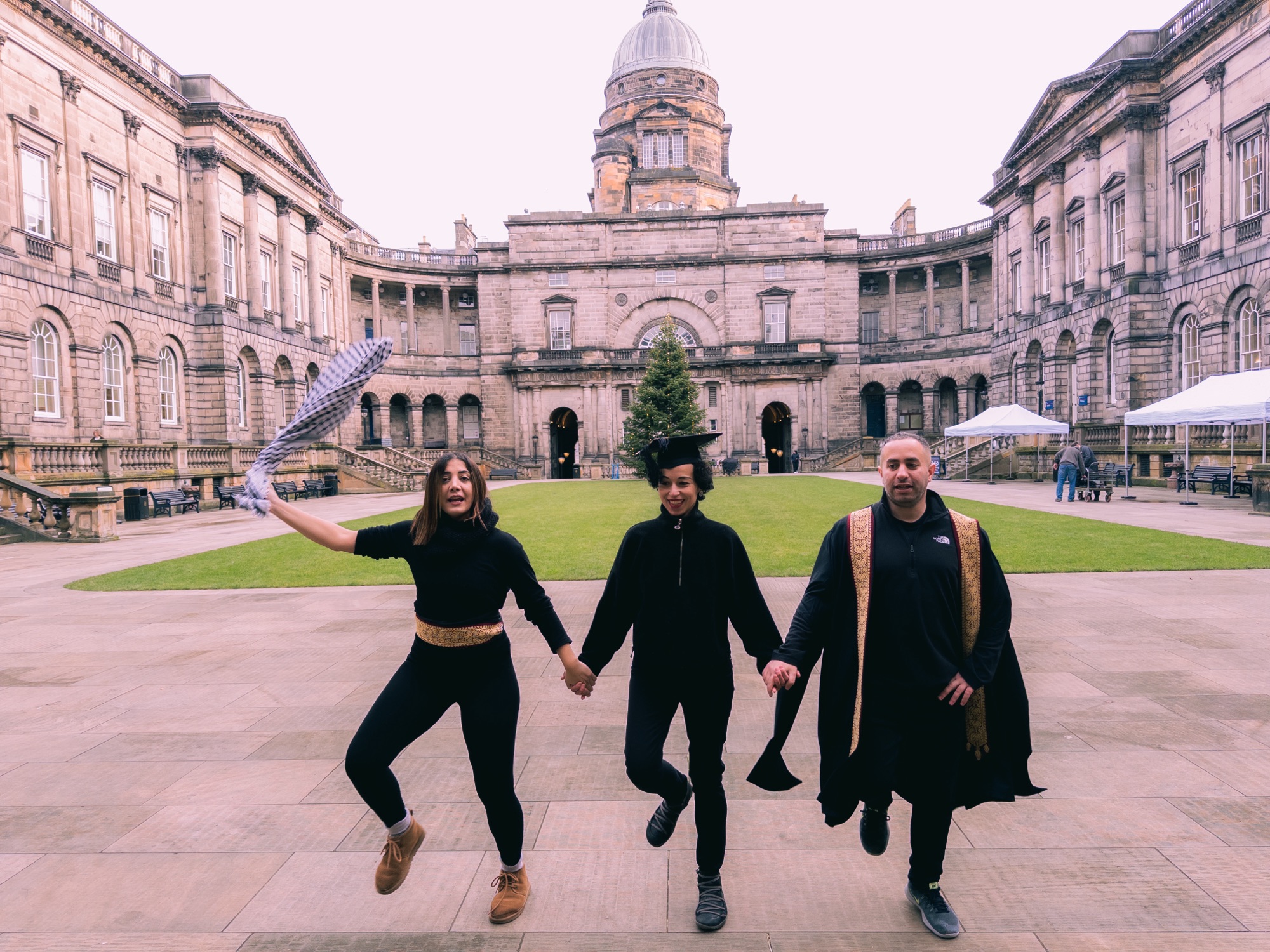Words by Hannah Draper.
I write this on day 123 of the ongoing genocide in Gaza and Palestine.
The day I see the show is December 14th, day 68 of the genocide. The work is presented at Inspace Gallery in the University of Edinburgh. It is a white and sterile room. The audience has been invited here to witness the work-in-progress performance lecture Balfour Reparations (2023-2043) created as part of choreographer and academic Farah Saleh’s PhD. As the audience walk in, we are handed an A4 piece of paper – a letter marked a with University of Edinburgh header. As I begin to read the letter, I realise it cannot be real – despite the justified demands for reparations. As we read, eight people are given a small rectangular square of fabric decorated with Palestinian embroidery. These people are later asked to come up on stage and read aloud paragraphs from the letter.
The letter was based on a ‘A Collective Statement Calling on the University of Edinburgh to Protect Speech on Palestine, Address the Intimidation on Campus, and Cut University Links to Violence’. This was sent by University of Edinburgh staff sent to the university senior management team in November 2023, outlining a set of demands to the University following increasing hostility towards those voicing and acting in support of Palestine.
From the outset, Farah employs collaboration by referencing and re-writing archive material – in movement, text and film. She tells me that her “process in creating work is usually very collaborative.” Her husband, academic Nicola Perugini, shared his collection of archives with her to make the piece. These were gathered materials which traced the legacy of Arthur Balfour, a Chancellor at the University of Edinburgh from 1891 to 1930, and who was instrumental in the creation of the Israeli state and occupation of Palestinian land in the signing of the Balfour Declaration in 1917. The archives were then shared with collaborator Lucas Chih-Peng Kao which helped develop the performance and video. Farah described the process of moving from research to movement “symbiotic” with both feeding one another to develop the work – “in the office I was trying movement and gestures and from these came the text.”
‘I never read the letter myself, it’s only the audience’
The performance is dependent on the audience’s participation. After the letter is read aloud by the selected audience members the first time, Farah then invites the audience to come on stage to read paragraphs aloud and to “take a step forward as volunteers.” It is important “that they want to do it…taking a step forward into their mobilisation of decolonising the university.” Bringing the audience into embodied collaboration with the performance, Farah speaks to me about the performance as an invitation to “allyship and mobilisation.”

Gesture and archive are vital parts of Farah’s artistic processes and creations. Balfour Reparations utilised these through using archival footage, which Farah references and adapts in her own movements. At one point, a video depicts Balfour inaugurating The Hebrew University in Jerusalem in 1925, alongside a split screen in which Farah stands in front of the University of Edinburgh’s McEwan Hall where students enrol, take their exams and graduate from the university. She inaugurates decoloniality at the University of Ediburgh in 2025, smiling out at an imagined audience – taking and adapting the gestures of Balfour in the video. Another video shows Palestinian dancers Nadia Khattab and Jamal Bajali dancing dabkhe (a traditional Palestinian dance) in front of Old College, a university building where it is speculated that Balfour signed the Balfour Declaration in 1947. The dancers helped Farah to “co-choreograph on the spot,” – marking a communal re-claiming of history and challenging the space with the presence of their bodies.
‘Creation of the future with all of this archive material’
As the audience, we are named as the ‘Evaluation Committee’ – who are responsible for reflecting on the letter and the reparations process. Farah, dressed in a black graduation robe adorned with golden Palestinian embroidery, and wearing a graduation hat asks the audience for their reflections, to which she then moves in response to the audience’s answers. Farah tells me she wanted to help the audience “envisage how their thoughts can be enacted in the future…and put in action…for them to see that.”
‘Palestino-futurism is very important at the moment because it could give us hope for a different future’
Farah talks the importance of Afro-futurist influence to the work, referencing ‘Palestino-futurism’ and artists such as Larissa Sansour who are using fantasy, sci-fi, imagination and multi- disciplinary methods that meld film, costume and music. Farah describes how “it’s really about an ideal future we are aspiring to and imagining.”
Alongside this re-imagining of the future, re-writing of archives and shifting history through embodying and adapting gestures, Farah uses a gentle humour through the work. “I tend to use humour in my performances as a way of inviting participation…but also an invitation for affect…humour as a way for people to feel at ease…a little smile or laugh can put them in a certain state of mind or make them more receptive to things.”
Again, it is a symbiotic process between Farah and the audience. She asks for a something, she gives us something back. It is an active and ongoing conversation in which collaboration and participation make and create the performance.
‘Inhabit gestures, bodies, and narratives to appropriate that building that has an ongoing colonial legacy’
Farah is now a lecturer in Global Majority Performance at Glasgow University, where Balfour was also a rector. The work may be developed further in response to this context, whilst also opening up to a wider UK context to explore Balfour’s various roles in government including as Prime Minister and Foreign Secretary. Farah tells me that the letter and films in the work would change to a fictive letter from the UK Government, exploring the “national colonial context relating to Balfour” and what reparations might look like on this scale.
I am curious about the process of working within these colonial institutions to make the work, and what that experience has been like. Farah tells me that the university are “talking about a race review and they want to see what can be done and changed, how they can confront this legacy. But it’s a very conservative university so it may take a very long time.”
Yet against this resistance to change and decolonisation, the piece shows the power and importance of active collaboration and participation to make collective change and to be involved in decolonising institutions. The work presents Palestinian culture with joy, community and hope – re-writing, re-dancing archives and histories to creatively engage with what reparations might look like. The space by the end of the performance feels like Farah has shifted the sterile institutional environment, instead fostering a sense of collective effort, action and connection in the audience.
———-
Balfour Reparations (2023-2043) was presented at Inspace Gallery, Edinburgh on December 14th 2023 to an invited audience. If you would like to follow Farah’s work, and the future development of this piece, please follow her website or social media links below.
Palestinian choreographer | Farah Saleh Website
Instagram: @farahsalehdance
Below are some resources and links to more information about the ongoing genocide in Palestine, the history of the Israeli occupation of Palestine and petitions, charities and fundraising standing in support and solidarity with the Palestinian people.
Resources
Scottish Palestine Solidarity Campaign
Boycott, Divest, and Sanction
Fundraising
